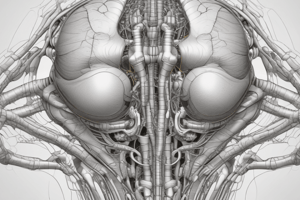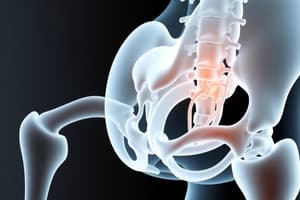Podcast
Questions and Answers
What is one of the basic functions of the pelvis?
What is one of the basic functions of the pelvis?
- to facilitate the movement of the organs involved with bowel and bladder
- to support the weight of the upper body and trunk to the femur
- to attach muscles of the lower extremity and the trunk (correct)
- to increase the diameter of the pelvis during walking
What type of joint is the sacrococcygeal joint?
What type of joint is the sacrococcygeal joint?
- Synarthrodial joint
- Synovial joint
- Diathrodial joint
- Symphysis (correct)
What is the function of the sacrococcygeal joint?
What is the function of the sacrococcygeal joint?
- To attach muscles of the lower extremity and the trunk
- To facilitate the movement of the organs involved with bowel and bladder
- To increase the anteroposterior diameter of the pelvis during labor and defecation (correct)
- To support the weight of the upper body and trunk
What type of joint is the sacroiliac joint in childhood?
What type of joint is the sacroiliac joint in childhood?
What is the primary function of the sacroiliac joint?
What is the primary function of the sacroiliac joint?
What is a primary stabilizer of the sacroiliac joint?
What is a primary stabilizer of the sacroiliac joint?
What type of movement occurs in the sacroiliac joint?
What type of movement occurs in the sacroiliac joint?
What is a characteristic of the pubic symphysis?
What is a characteristic of the pubic symphysis?
What is nutation defined as in relation to the sacrum and ilium?
What is nutation defined as in relation to the sacrum and ilium?
What is the primary function of nutation and counternutation in the pelvis?
What is the primary function of nutation and counternutation in the pelvis?
Which of the following muscles helps to stabilize the SIJ?
Which of the following muscles helps to stabilize the SIJ?
What is the movement of the sacrum during retroversion?
What is the movement of the sacrum during retroversion?
What is the movement of the ASIS during anteversion?
What is the movement of the ASIS during anteversion?
What is the movement of the sacrum during lateral tilt?
What is the movement of the sacrum during lateral tilt?
Which of the following is NOT a function of nutation and counternutation?
Which of the following is NOT a function of nutation and counternutation?
What is the movement of the contralateral ASIS during rotation?
What is the movement of the contralateral ASIS during rotation?
Flashcards are hidden until you start studying
Study Notes
Pelvic Biomechanics
- The pelvis serves as an attachment point for many muscles of the lower extremity and trunk.
- It transmits the weight of the upper body and trunk to the ischial tuberosities.
- With the help of the muscles and connective tissues of the pelvic floor, the pelvis supports the organs involved in bowel and bladder functions.
Intrinsic Joints of the Pelvis
- Sacrococcygeal joint:
- Located between the apex of the sacrum and the base of the coccyx.
- A symphysis joint lined by hyaline cartilage and connected by an interposed fibrous disc.
- Has limited movements of flexion and extension, with one degree of freedom.
- Function: increases the anteroposterior diameter of the pelvis during labor and defecation.
- Pubic symphysis:
- Hyaline cartilage lines the surface of the articulation.
- Joint is firmly bound by a fibrocartilaginous interpubic disc and ligaments.
- Allows up to 2 mm of translation and very slight rotation.
- Sacroiliac joint (SIJ):
- A modified synarthrodial joint.
- Functions: transitions forces from the pelvic to caudal region, and provides stability for effective transfer of loads.
- Primary stabilizers: anterior sacroiliac, iliolumbar, posterior sacroiliac, and interosseous ligaments.
- Secondary stabilizers: sacrotuberous and sacrospinous ligaments.
Kinematics of the Pelvis: SIJ
- Mainly small rotational and translational movements of the SI joints.
- Movements based on compression of articular cartilage.
- Anthropometric measurements: 1-4 degrees of rotation and 1-2 mm of translation.
- Nutation and counternutation:
- Nutation: relative anterior tilt of the top of the sacrum, relative to the ilium.
- Counternutation: relative posterior tilt of the top of the sacrum, relative to the ilium.
- Functional considerations of nutation and counternutation:
- Joint stress relief: releases the pelvis from joint stress during support phases.
- Stability during load changes: increases congruency and stability.
Muscles that Stabilize the SIJ
- Erector spinal
- Lumbar multifidi
- Abdominal muscles
- Hip extensors
- Latissimus dorsi
- Iliacus and piriformis
Arthrokinematics of the Pelvis
- Anteversion:
- Anterior tilt
- Descent of ASIS
- Ascent of PSIS
- Sacrum: counternutation
- Lumbar extension movement
- Retroversion:
- Posterior tilt
- Ascent of ASIS and descent of PSIS
- Sacrum: nutation
- Lumbar flexion movement
- Lateral tilt:
- Lateral movement
- Descent of ASIS from one side
- Ascent of contralateral ASIS
- Associated with movements of abduction and adduction
- Rotation:
- Anterior movement of ASIS of one side
- Posterior movement of the contralateral ASIS
- Associated with movements during gait
Studying That Suits You
Use AI to generate personalized quizzes and flashcards to suit your learning preferences.




